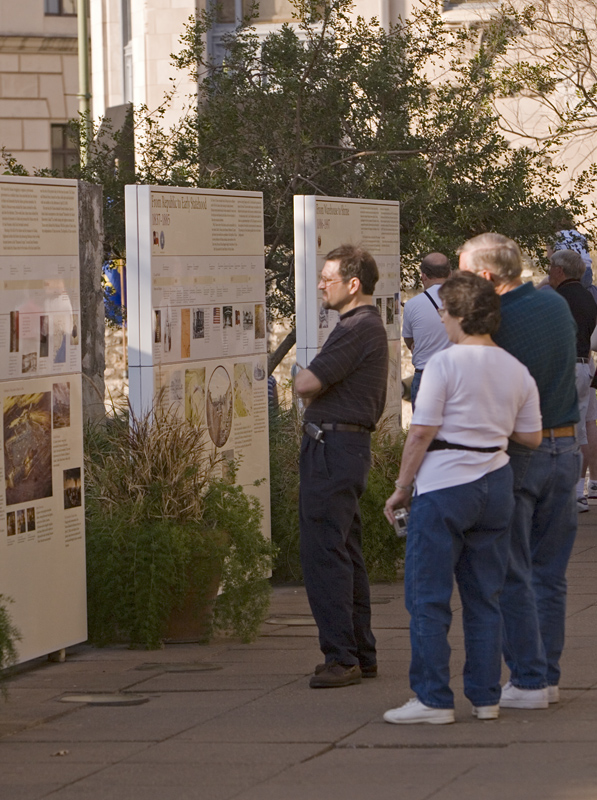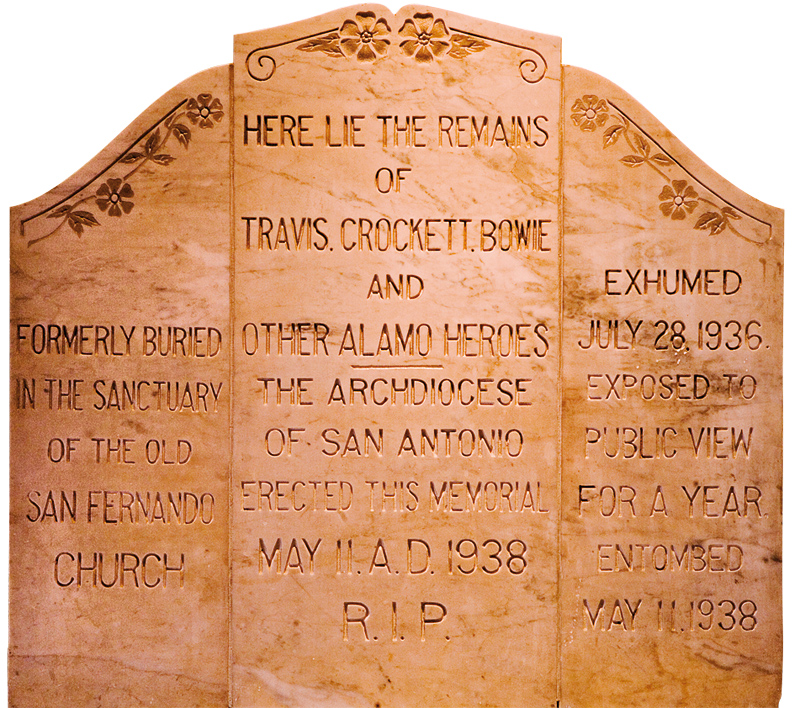< San Antonio & Austin's Top 10
 The Alamo
The Alamo
World renowned as a symbol of bravery and defiance, the Alamo today is maintained as a shrine to the heroes of March 1836. The first Spanish mission to be built along the San Antonio River, it was nicknamed the Alamo by the Spanish military after the 1790s. It served as an outpost for Spanish, then rebel, and finally Mexican forces until 1835, when Ben Milam defeated Mexican General Cós to occupy the Alamo.
Top 10 Features
 Chapel
Chapel

The mission chapel is maintained as the Shrine of Texas Liberty in honor of the heroes who fought here against overwhelming odds for 13 days in 1836. The large door at the rear once led to the residence of defender James Bowie’s in-laws.
 Sacristy Rooms
Sacristy Rooms
The small sacristy rooms were the only quarters in the chapel with a ceiling in 1836, and were used to shelter women and children during the siege. Today, they display battle artifacts, such as William Barret Travis’s ring and a buckskin vest belonging to Davy Crockett (For further details see December 1835 – February 22, 1836).
 Clara Driscoll Theater
Clara Driscoll Theater
The small theater is located in the Long Barrack. A superb short film presents the historic events leading up to the Battle of the Alamo, and the 13-day siege that ended shortly after dawn on March 6, 1836.
 Long Barrack
Long Barrack
Some of the bloodiest fighting of the 1836 battle occurred in this long, narrow building, the mission convento where priests once lived. The Long Barrack and the mission church are the only two original buildings that remain. Exhibits at this museum tell the story of the Alamo.
 Wall of History
Wall of History

This exhibit presents 300 years of history, starting with the Native American inhabitants, and the start of the mission and its secularization. The military history began when it was leased to a Spanish cavalry unit who nicknamed it the Alamo.
 Alamo Plaza
Alamo Plaza
Much of the battle took place within the mission grounds, in the area in front of the Chapel and the Long Barrack that today is Alamo Plaza. A plaque marks the location of the Low Barrack, which was the original entrance.
 Alamo Cenotaph
Alamo Cenotaph
The 60 ft (18 m) high granite and marble monument is a memorial to the men who died in 1836. Names and images of the heroic defenders are incorporated into The Spirit of Sacrifice created by Pompeo Coppinni.
 Gift Museum
Gift Museum
This large museum and gift shop was built in 1939 and displays historical portraits and documents. The highlight here is the large diorama of the final assault created by Thomas Feely.
 Acequia
Acequia
The remains of the original acequia, or hand-dug ditch, which brought water from the river into the compound, can still be seen behind the Chapel and the Gift Museum. This reliable source of water bolstered the confidence of the defenders as they waited for the battle.
 Daughters of the Republic of Texas (DRT) Library
Daughters of the Republic of Texas (DRT) Library
Built in 1950, this fine research library was developed by the DRT, who saved the Alamo from being turned into a hotel. The non-circulating collections explore the history of Texas. The important documents here include Santa Anna’s will and a copy of the Texas Declaration of Independence.
Tip: Men are asked to remove their hats as they enter the Chapel, and photography is not allowed inside.
Tip: Be sure to see the Long Barrack Museum and the film in the Clara Driscoll Theater.
Tip: Costumed actors are onsite the first Saturday of every month.
Tip: There are fast food restaurants across the street along N Alamo, but a better choice is the Colonial Room in the Menger Hotel.
Mission San Antonio de Valero
Visitor Information
- 300 Alamo Plaza
- 210 225 1391
- Open Sept–May: 9am–5:30pm Mon–Sat, 10am–5:30pm Sun; Jun–Aug: 9am–5:30pm Mon–Thu, 9am–7pm Fri–Sat, 10am–5:30pm Sun
- Adm: Free, but donations help maintain the shrine
- Partial dis. access
- www.thealamo.org
< San Antonio & Austin's Top 10
 Battle of the Alamo
Battle of the Alamo
 December 1835 – February 22, 1836
December 1835 – February 22, 1836
Colonel Ben Milam led 300 volunteers against Mexican troops in December 1835. After five days of fighting, during which Milam died, Mexican General Cós surrendered and the Texans took over the Alamo. James Neill assumed command. Between January 19 and February 8, James Bowie, William Travis, and Davy Crockett arrived with more troops. On February 14 Neill left on an emergency and Travis took over command of the military, while Bowie led the volunteers.
 February 23
February 23
Antonio López de Santa Anna, enraged by the defeat of Cós, reached San Antonio with his troops. The Texans retreated into the Alamo complex, and Santa Anna sent a courier offering an honorable surrender. Travis replied by firing a cannon, and Mexicans began to bombard the walls.
 February 24
February 24
Travis assumed full command after Bowie fell ill, and wrote a letter addressed to all Texans and Americans, recounting the 24-hour bombardment, pledging that he would not surrender, and asking for immediate aid. Couriers James Bonham, Juan Seguin, and others rode out for help.
 March 1
March 1
Lieutenant George Kimbell and 32 men from Gonzales made their way through the Mexican lines and into the Alamo. The number of defenders reached an estimated 189 men. Travis welcomed the reinforcements, but knew he needed far more.
 March 2
March 2
The Texas Declaration of Independence from Mexico was approved by delegates meeting at Washington-on-the-Brazos. On March 3, Travis sent a courier to the delegates asking for more troops, and reaffirming his intention to fight unto death, but no reinforcements were sent.
 March 5
March 5
On day 12, Santa Anna announced that the assault would begin the next day. His officers recommended waiting for the inevitable surrender when the Alamo ran out of provisions.
 March 6, Before Dawn
March 6, Before Dawn
At about 5am on Sunday, March 6, the Mexican attack began. Mexican troops advanced from all directions toward the battered compound walls.
 March 6, The Alamo
March 6, The Alamo
When an estimated 1,800 Mexican troops advanced within range, the Texans fired their cannons and rifles. The heavy bombardment forced the Mexican troops to halt but they quickly re-formed and attacked again, penetrating the north wall. Travis was one of the first to die.
 March 6, Long Barrack
March 6, Long Barrack
Once the north side was penetrated, the beleaguered defenders had to retreat to the Long Barrack’s narrow rooms, where the bloodiest close combat occurred. Bowie died in the chapel, which was the last part of the building to fall. Soon after dawn the battle was over.
 March 6, Aftermath
March 6, Aftermath
The entire battle lasted less than 90 minutes. It is believed that all 189 defenders and 600 Mexican soldiers perished in the fight. Santa Anna pledged safe passage to non-combatant women, children, and slaves who were in the Alamo complex during the battle.
Remember The Alamo!

Detail, Alamo Memorial
The defeat at the Alamo galvanized the Texans, alerting them to the real danger of Santa Anna’s army, and the reality that the war for independence from Mexico was far from finished. Six weeks later, on April 21, Sam Houston led his volunteer army into battle against Santa Anna and the Mexican forces at San Jacinto. Houston caught Santa Anna napping and attacked the Mexican army during their siesta. With the battle cry, “Remember the Alamo!”, he defeated the army and captured Santa Anna. Victory at San Jacinto came just six weeks after the gruesome slaughter at the Alamo, and earned Texas its long-sought independence from Mexico. Ever since, “Remember the Alamo!”, has served as a popular rallying cry, reminding Texans and Americans of the importance of being willing to fight to protect their freedom.